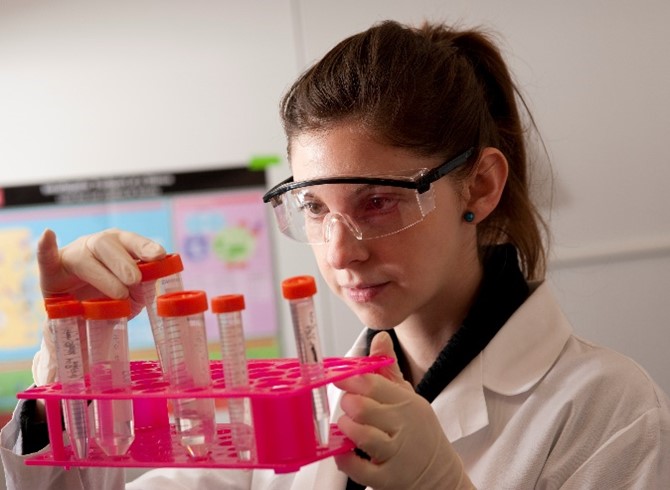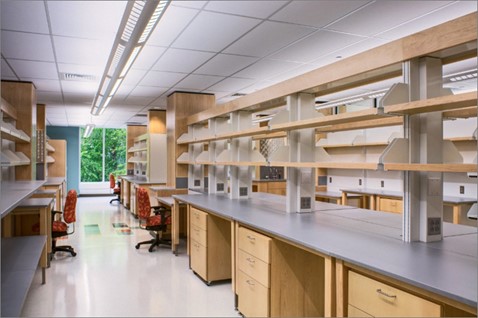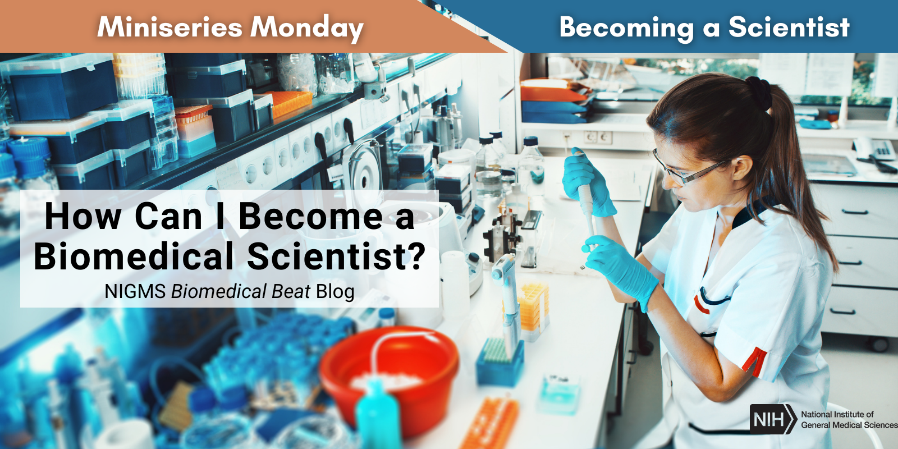Do you love learning about science but aren’t sure how to turn it into a career? Or maybe you already know that you want to be a scientist but you’re wondering what steps it takes? If this sounds like you, you’ve come to the right place!

For most people, the path to becoming a scientist starts in the classroom, where you might be introduced to topics like biology, chemistry, and physics. After high school, some science-loving students choose to follow a path to becoming a doctor or a teacher, but those are just two of the many biomedical scientific careers available. Regardless of what field you’re interested in, here’s a rough guide to the different levels of training that scientists may have.
Undergraduate
After high school, you’ll enroll in college as an undergraduate student to earn a bachelor’s degree. Common science majors include biology, chemistry, biochemistry, microbiology, computer science, and many more. Do some online research to see what interests you and get advice from your guidance counselors. But don’t be afraid of making a decision that turns out not to be the best fit—you can take classes in a variety of subjects, and most colleges allow you to change your major during your 4 years of undergrad.
Undergrad is a great time to get hands-on experience in science by joining a lab. If your school has an office of undergraduate research, start by talking to them about where to get involved in research. If your school doesn’t have an office specifically for matching students and research labs, talk to your professors because they may have openings in their own labs or know of labs recruiting students to help with research projects. If your school doesn’t have research labs on campus, you may be able to find one to join at a nearby university. Or you can apply for a research experience for undergrads (REU)—a type of program that helps students get involved in research, usually over the summer, and often comes with payment in the form of a stipend. Working in a research lab during undergrad gives you the opportunity to learn which fields you’re the most interested in, get a taste for what a career as a researcher might be like, and gain great experience to list on your resume.
Graduate School
Students who go to graduate school can earn a master’s degree and/or a doctoral degree. Master’s degree programs are often 2 years long and involve classes in your field of choice and often research in a lab. It’s common that the program will end with a written thesis and presentation based on either classwork or lab work.
Students can enter a Ph.D. program directly after undergrad or after a master’s program. These programs usually start with 1 year of classwork and laboratory research rotations, where you spend 2-3 months in different labs getting to know the professor and getting exposure to their research to learn which one could be the best fit for you. After that, you dedicate 3-5 years to research in your selected lab. With the help of an advisor, you’ll develop your own research project, devise experiments to answer scientific questions, gather and analyze data, and share your results with the scientific community through publishing in journals or presenting at conferences. Attending scientific conferences is also a great opportunity to meet other scientists in your field. While these years in the lab can be challenging, they can also be very rewarding.
Sometimes the labels advisor and mentor are used interchangeably to refer to the same person. But there’s a difference between them! The person running the lab that you join becomes your advisor (you could have more than one if multiple people are in charge). Their job is to oversee the science occurring in the lab, so they act as your scientific director. When choosing a lab, it’s important to consider the type of science you want to do and the advisor’s directing style to make sure that both are a good fit for you.
A mentor is more like a guide or a coach—they help you navigate your training and career with personal input tailored to you. Some advisors are also great mentors, but you may still seek mentorship from other people, such as other professors, graduate program coordinators, or even senior lab members. Many students find it helpful to seek out mentors who have similar lived experiences or have achieved success in their chosen path. It’s not uncommon to have several mentors, as they can provide advice and perspective on different aspects of your career and training.
Like master’s degree programs, a Ph.D. ends with a formal presentation of the results you’ve collected as well as a longer, more in-depth written dissertation. Many Ph.D. programs in the sciences also come with tuition coverage and a stipend—wages you earn a while in school. (Some master’s programs, like those funded by the NIGMS Bridges to the Doctorate Program, also have these benefits, but they’re not as common.)

Other doctoral programs include clinician training, such as medical, pharmacy, or veterinary school (M.D., Pharm.D., or D.V.M., respectively). Some people choose to become clinician scientists, so in addition to earning a Ph.D., they also earn a clinical degree like an M.D., Pharm.D., or D.V.M. While the individual clinical degree programs don’t usually come with tuition coverage and stipends, some dual-degree programs, like those funded by the NIGMS Medical Scientist Training Program (MSTP) or the Leading Equity and Diversity MSTP, do.
Postdoctoral Training
After you finish grad school, if you decide you want to consider a career in research, you can choose further training in the form of postdoctoral work (a “postdoc”), usually in a different lab than the one you trained in during grad school. In many cases, the lab you join will study a similar topic but in a different way, so that you learn new techniques you weren’t exposed to during grad school. For example, if your Ph.D. focused on how to make specific types of molecules through chemical synthesis, you may choose a more biologically focused postdoc where you learn how to test those types of molecules in cells or research organisms. The length of a postdoc can vary from 1 to several years, during which you’ll continue to hone your skills as a researcher and become more independent.
Getting a Job
The next stage is applying for jobs that you feel best fit your life and scientific goals. In the second post of this miniseries, we cover some of the many different types of career positions scientists can have, such as:
- Researching and teaching at colleges or universities
- Working as a scientist in the pharmaceutical, agricultural, or other industries
- Serving in a regulatory position within government
- Working in nonprofit scientific groups
Although the educational path outlined in this post is common, it’s by no means the only one. For example, many people choose to work as laboratory technicians after college before they pursue graduate degrees, many take time off to focus on their families, and some even spend years working in different careers before taking this path. And not every position requires every level of education and training, so identifying your career goals early can help identify your training needs. No matter what your current stage is in your journey through science, you can turn your dreams into reality.
NIGMS offers research training programs for scientists at all stages in their careers, from high schoolers to faculty members, to support the development of a biomedical research workforce to meet the nation’s needs. Many colleges and universities across the country are recipients of NIGMS-funded training programs for undergraduate and graduate students that may offer tuition coverage or help you get involved in research.

Learn more in our Educator’s Corner.
Other Posts You May Like
- Understanding Signaling Through Cell Membranes: Q&A With Chrystal Starbird
- Bil Clemons: Following Scientific Curiosity
- From Science Fair to Science Lab: Q&A With Chelsey Spriggs
- Haley Bridgewater: Taking the Sting Out of Vaccines
- Investigating the Inner Workings of Ion Channels With Sudha Chakrapani







